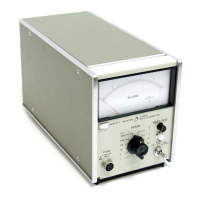
Do you have a question about the HP 4328A and is the answer not in the manual?
| Brand | HP |
|---|---|
| Model | 4328A |
| Category | Measuring Instruments |
| Language | English |
Ensures the instrument chassis is connected to an electrical ground to minimize shock hazard.
Warning against operating the instrument in the presence of flammable gases or fumes.
Instructs personnel not to remove covers and to disconnect power before touching circuits.
Advises against attempting internal service unless another qualified person is present.
Warns against unauthorized modifications and recommends returning the instrument for service.
Highlights warnings that precede potentially dangerous procedures.
Defines symbols indicating hazards that could result in injury or death.
Defines symbols indicating hazards that could result in damage to the product.
Defines the symbol for important information essential to highlight.
Certifies compliance with radio frequency interference requirements.
Specifies the acoustic noise emission level of the instrument.
Lists corrections for errors found in the existing manual.
Details modifications and updates to the manual based on serial number or instrument changes.
Provides an overview of the Model 4328A Milliohmmeter's capabilities and features.
Lists the standard accessories included with the Milliohmmeter.
Explains how to identify the instrument using serial numbers and prefixes.
Details how to adapt the manual for different serial prefixes or instrument versions.
Outlines the information covered in the installation section.
Provides instructions for unpacking and inspecting the instrument for damage.
Details proper packaging and environmental conditions for storage and shipment.
Describes how to install the unit for bench or rack mounting.
Explains how to connect the instrument to the power source.
Overview of the instrument's use in measuring contact resistance and incremental resistance.
Explains the front and rear panel controls, connectors, and indicators.
Details operation using the internal rechargeable battery and charging procedures.
Describes the measurement process using the 4-terminal method.
Provides a step-by-step guide for operating the instrument.
Detailed explanation of the front panel controls and their functions.
Detailed explanation of the rear panel controls and connectors.
Instructions for setting the mechanical zero of the meter movement.
Explains the basic principles of measurement and the 4-terminal method.
Provides a high-level overview of the instrument's functional blocks.
Describes the operation of the 1kHz oscillator circuit.
Explains the function of the Schmitt trigger circuit for range indication.
Details the function of the 20mV peak limiter.
Explains the operation of the phase sensitive voltmeter section.
Outlines routine maintenance, performance checks, adjustments, calibration, and troubleshooting.
Describes procedures to verify instrument specifications and performance.
Details the adjustment procedures necessary to calibrate the Milliohmmeter.
Lists instruments and accessories required for adjusting and testing the instrument.
Procedure for checking the linearity of the instrument's readings.
Procedure for checking the instrument's full-scale readings.
Instructions for removing and replacing the instrument's covers.
Step-by-step guide for removing the bottom cover.
Detailed calibration procedures for the Model 4328A.
Procedure for adjusting the meter's mechanical zero.
Instructions for checking the DC power supply voltages and ripple.
Procedure for adjusting the bias on the oscillator output transistor.
Information and tests to help determine if a transistor or other component is faulty.
Methods for testing transistors outside the circuit using an ohmmeter.
Guidelines for replacing components on etched circuit boards.
Information on ordering replacement parts, reference designators, and stock numbers.
Instructions on how to address orders or inquiries for replacement parts.
Describes standard modifications performed on instruments at the factory.
Information on instruments modified according to customer specifications.
Explains how to adapt the manual for different serial prefixes or instrument versions.
Guidance for adapting the manual to instruments with higher serial prefixes.
Instructions for adapting the manual to instruments with lower serial prefixes.
Details specific updates and corrections to the manual, organized by change number.
Overview of troubleshooting instructions, schematics, and component locations.
Provides charts and procedures for diagnosing and resolving instrument malfunctions.
Presents circuit diagrams with signal routing, voltage levels, and test points.
Details measurement conditions and locations for test points.
Lists specific test points for observing waveforms.
Illustrations showing internal component locations for troubleshooting.
Diagnostic flow chart for the Flip-Flop circuit (A3).
Diagnostic flow chart for the Limiter circuit (A3).
Diagnostic flow chart for the AC Amplifier circuit (A2).
Diagnostic flow chart for Phase Detector and DC Amplifier circuits (A2).
Diagnostic flow chart for the Modulator circuit (A2).
Diagnostic flow chart for the main power supply (A1).
Diagnostic flow chart for the Ni-Cd battery power supply (A6).
Illustrates component locations on the Oscillator Assembly (A3).
Illustrates component locations on the Range Switch Assembly (A4).
Illustrates component locations on the Phase Sensitive Amplifier Assembly (A2).
Illustrates component locations on the Mother Board Assembly (A5).
Illustrates component locations on the Power Supply Assembly (A1).
Illustrates component locations on the Ni-Cd Power Supply Assembly (A6).